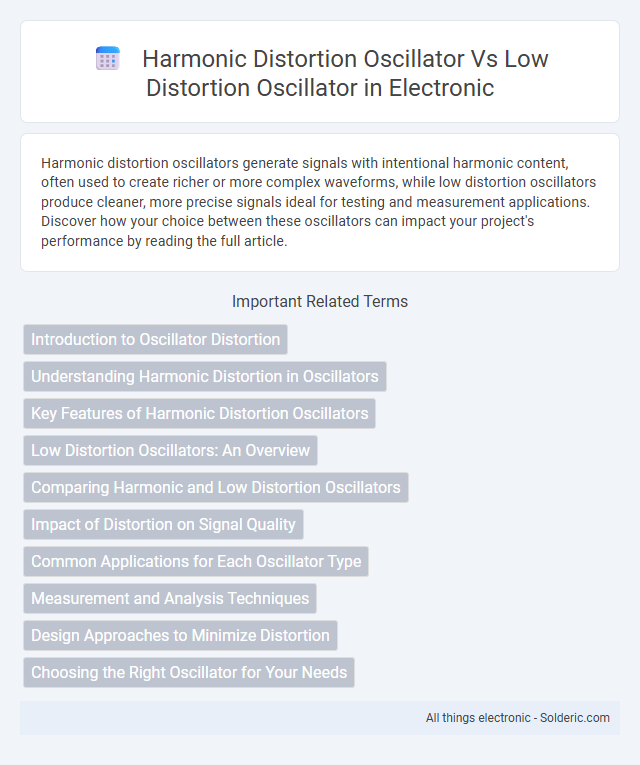Harmonic distortion oscillators generate signals with intentional harmonic content, often used to create richer or more complex waveforms, while low distortion oscillators produce cleaner, more precise signals ideal for testing and measurement applications. Discover how your choice between these oscillators can impact your project's performance by reading the full article.
Comparison Table
| Feature | Harmonic Distortion Oscillator | Low Distortion Oscillator |
|---|---|---|
| Primary Purpose | Generates signals with intentional harmonic distortion for effect or testing | Produces clean signals with minimal harmonic distortion for precision applications |
| Harmonic Distortion Level | High to moderate harmonic content | Very low harmonic distortion, typically <1% |
| Signal Purity | Lower signal purity due to added harmonics | High signal purity and fidelity |
| Typical Applications | Audio effects, musical synthesizers, distortion testing | Precision measurement, calibration, communication systems |
| Design Complexity | Simpler circuit design, sometimes using non-linear components | Complex design with filters and feedback to minimize distortion |
| Output Waveform Quality | Rich in harmonics, possibly clipped or distorted waveform | Clean sine wave or desired waveform with minimal noise |
| Examples | Wave-shaping circuits, diode-clipping oscillators | Wien bridge oscillators, crystal oscillators |
Introduction to Oscillator Distortion
Oscillator distortion refers to unwanted alterations in the output waveform that degrade signal purity, affecting performance in communication and audio systems. Harmonic distortion oscillators generate frequency components at integer multiples of the fundamental frequency, causing signal coloration and reduced fidelity. Low distortion oscillators minimize harmonic content, delivering cleaner sine waves essential for precision instrumentation and high-quality audio applications, ensuring Your signals maintain integrity and accuracy.
Understanding Harmonic Distortion in Oscillators
Harmonic distortion in oscillators arises when nonlinearities in the circuit generate unwanted frequency components at multiples of the fundamental frequency, significantly affecting signal purity. Harmonic distortion oscillators allow controlled levels of distortion beneficial in certain applications like sound synthesis, whereas low distortion oscillators prioritize minimizing harmonics to preserve waveform accuracy and signal integrity in precision instrumentation. Analyzing distortion metrics such as Total Harmonic Distortion (THD) enables engineers to select or design oscillators tailored to specific performance requirements.
Key Features of Harmonic Distortion Oscillators
Harmonic distortion oscillators generate waveforms rich in harmonics, creating complex signals ideal for audio synthesis and testing applications where tonal color and texture matter. Key features include stable frequency output despite intentional waveform non-linearity, the ability to emphasize specific harmonic orders, and adjustable distortion levels to tailor sound character. Your choice of harmonic distortion oscillator enables precise control over harmonic content, enhancing both creative sound design and technical analysis.
Low Distortion Oscillators: An Overview
Low distortion oscillators are designed to minimize harmonic distortion, producing cleaner and more accurate sine waves essential for high-fidelity audio and precise signal generation. These oscillators utilize advanced circuit topologies and feedback mechanisms to suppress unwanted harmonics, ensuring your output signal maintains integrity with minimal noise. Compared to harmonic distortion oscillators, which intentionally generate harmonics for specific effects, low distortion oscillators prioritize signal purity for critical applications in communications, testing, and instrumentation.
Comparing Harmonic and Low Distortion Oscillators
Harmonic distortion oscillators generate signals containing multiple harmonic frequencies that can significantly affect waveform purity, making them suitable for applications requiring complex tone creation. Low distortion oscillators are designed to minimize harmonic content, producing cleaner and more accurate sine waves essential for high-precision measurements and audio synthesis. Comparing these oscillators highlights a trade-off between harmonic richness and signal fidelity, influencing their selection in signal processing and communication systems.
Impact of Distortion on Signal Quality
Harmonic distortion oscillators introduce nonlinearities that generate unwanted harmonics, significantly degrading signal purity and causing interference in sensitive applications. Low distortion oscillators maintain signal integrity by minimizing harmonic content, resulting in clearer, more accurate waveform generation essential for high-fidelity audio and precision measurement. Your choice directly affects overall system performance, making low distortion oscillators preferable when waveform accuracy and minimal noise are critical.
Common Applications for Each Oscillator Type
Harmonic distortion oscillators are commonly used in audio testing and signal processing applications where the analysis of harmonic content is crucial for evaluating system linearity and distortion levels. Low distortion oscillators are preferred in precision measurement, calibration, and communication systems that demand highly pure, stable signals with minimal unwanted harmonics to ensure accurate and reliable performance. Both oscillator types serve different roles in electronic design and testing environments, with harmonic distortion oscillators aiding in distortion characterization and low distortion oscillators supporting high-fidelity signal generation.
Measurement and Analysis Techniques
Measurement of harmonic distortion oscillators typically involves analyzing total harmonic distortion (THD) using spectrum analyzers or distortion analyzers to identify and quantify harmonic components relative to the fundamental frequency. Low distortion oscillators require advanced techniques such as two-tone testing and phase noise analysis to ensure minimal signal contamination and high purity output. Your choice of measurement tools directly impacts the accuracy of distortion characterization and the reliability of oscillator performance assessment.
Design Approaches to Minimize Distortion
Design approaches to minimize distortion in harmonic distortion oscillators focus on precise feedback loop control and nonlinear element optimization to reduce unwanted harmonic content. Low distortion oscillators typically utilize high-quality components, temperature compensation, and advanced filtering techniques to maintain waveform purity and stabilize frequency output. Your choice depends on whether minimizing harmonic distortion or achieving overall low total harmonic distortion is more critical to your application.
Choosing the Right Oscillator for Your Needs
Selecting the right oscillator depends on the application requirements for signal purity and complexity. Harmonic distortion oscillators generate complex waveforms rich in harmonics, ideal for audio synthesis and testing equipment, but may introduce noise in precision measurements. Low distortion oscillators offer cleaner, more stable signals essential for communications, instrumentation, and high-fidelity systems where minimizing harmonic distortion is critical.
Harmonic distortion oscillator vs Low distortion oscillator Infographic

 solderic.com
solderic.com